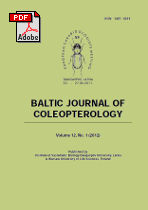Does the Mean Individual Biomass (MIB) of carabids as a bioindicator of forest succession follow a logistic function? - Examples from Western German beech and Polish Scots pine forests
Main Article Content
Keywords
:
Carabidae, mean individual biomass, MIB, logistic function, bioindicator, forest, succession
Abstract
Communication No. 384 of the Laboratory of Evaluation and Assessment of Natural Resources, Warsaw University of Life Sciences - SGGW.<br /><br />Successional processes are a common element of commercial forest monocultures. Here, after harvesting and replanting the trees, large parts of the forest ecosystem start from early successional stages at the same time. Of course, succession depends on various site-dependent factors, but there are patterns broadly relevant for successional processes in forestry. One of these patterns may be underlying the course of development of epigaeic ground-beetle assemblages (Coleoptera: Carabidae) as can be followed, e.g., by monitoring the Mean Individual Biomass (MIB) of carabids over time. In Western German beech stands of increasing age (14 stands, 1 - 165 years) and in Polish Scots pine forests (14 stands, 21 - 119 years) MIB has been described by a logistic growth function showing different shapes probably as a consequence of good vs. poor soil quality. A mathematical model has been developed which regresses field data on ecological succession and supplies information on, e.g., the initial degradation, the onset and speed of succession, and the ecological capacity of the geographical region and forest type. The model is subject to further amendment.
Article Details
Statistics
Downloads
Download data is not yet available.
Recommend Articles
